

Polonia
Benvenuto in


Nome ufficiale: Repubblica di Polonia
Capitale: Varsavia
Forma di Governo: Repubblica Parlamentare
Valuta: Złoty (PLN)
Area: 312.685 km²
Popolazione: 38 milioni
Altre città importanti: Cracovia, Danzica, Breslavia, Poznan, Katowice, Gdynia, Zakopane
By Henryk Niestrój - Pixabay
La Polonia offre bellezze naturali e una storia e cultura ricca e intrigante. Il paese ha sofferto più della maggior parte durante la seconda guerra mondiale e gran parte del paese è stato restaurato dopo il 1945, per la loro antica bellezza. È un paese europeo moderno, ricco di cultura ed energia.
Gli amanti della natura possono godersi i laghi idilliaci della nazione, le foreste di smeraldi e le montagne mozzafiato. Il distretto lacustre di Mazury è perfetto per gli sport acquatici e le località lungo la costa baltica sono famose per le destinazioni balneari con città portuale di Danzica e Castello di Malbork. I Monti Tatra sono ideali per il trekking e lo sci. Per gli amanti della storia che vogliono saperne di più sulla Seconda Guerra Mondiale, i 3 campi di concentramento racconteranno la storia completa dell'orrore di guerra. La foresta polacca di Bialowieza ospita la più grande popolazione mondiale di bisonti, o bisonti europei.
Varsavia
La capitale nazionale, Varsavia, moderna e dinamica, famosa per le sue vivaci scene della vita notturna, il Museo dell'insurrezione di Varsavia, i ristoranti di classe mondiale e l'affascinante architettura medievale.
Old Town
Immediately after the war, the Old town was restored to its pre-war condition, in a five-year reconstruction campaign by its citizens, resulted in today's meticulous restoration of a span of history covering the 13th to the 20th century. The Old town was inscribed as UNESCO World Heritage Site in 1980.
The charming Square is flanked by many restaurants, café , Renaissance and Baroque merchants’ houses in a spectrum of colours. In the middle of the square stands a statue of the Warsaw Mermaid, the emblem and guardian of the city.
Krakowskie Przedmieście Street
After touring the Old Town, head along Krakowskie Przedmieście street, arguably the most elegant street of the city, on which many culturally important buildings and monuments are located. The one-mile long street, links the Old Town and the Royal Castle. You’ll see palaces, dignified monuments and eminent Polish institutions like the Polish Academy of Sciences, Warsaw University and the Presidential Palace.
Royal Castle
Located on Castle Square at the entrance to Old Town, Warsaw’s Royal Castle was the seat of the Polish royalty between the 16th and 18th centuries. The castle was completely destroyed by the German army during World War II and, because of the Communist regime, it was only reconstructed in the 1980s, but it blends into the Old Town’s atmosphere very well. The castle is a museum today, hosting an impressive collection of paintings and furniture from the 16th century. Among other great pieces, are two Rembrandt’s paintings.
Łazienki Park
Warsaw’s largest park , initially built as royal baths and was enriched in the 18th century. Hopping from one pavilions to another, marvelling at the sumptuous Łazienki Palace or just relaxing in the greenery. One of the most prestigious monuments in the park is composer Frédéric Chopin, designed in 1907 in the Art Nouveau style. To understand more about Chopin and see his last piano, head to the Chopin Museum on Okolnik Street.
Warsaw Uprising Monument on Krasiński Square
A tribute to the Polish insurgents who fought in the failed attempt to end their city's Nazi occupation in August 1944. Those who would like to get to know the turbulent yet fascinating contemporary history of the city should visit this museum.
Palace of Culture and Science
The Palace of Culture and Science is the tallest building in Poland It is a multi-functional building that houses everything from companies to entertainment venues. You can access the Palace’s terrace on the 30th floor and enjoy a mesmerizing 360° view of Warsaw.
Copernicus Science Centre
Poland’s top science museum opened in 2010 and has more than 400 interactive exhibits across six zones, each tackling a different field, from the Roots of Civilisation to the Lightzone, investigating the nature of light, and enable visitors to single-handedly carry out experiments and discover the laws of science for themselves. In the centre, there's also a 3D planetarium where visitors can see more than just images of the starry sky and related films. The shows concern a variety of popular science issues, including from the field of astronomy, natural science and ethnography.
The Scence Centre is the largest institution of its type in Poland and one of the most advanced in Europe.
Wilanów Palace
Wilanow Palace is one of the most important monuments in Poland, representing what Poland was like before the 18th century. The palace was built as a home for King John III Sobieski. After his death the palace was owned by private families, each one changing the way the palace looked.
The royal palace survived WWII almost unscathed, and most of its furnishings and art were reinstalled after the war. Today, it is a museum that is home to the country’s artistic and royal heritage. It hosts several music festivals, including the summer concerts in the garden
Cracovia
Un'altra famosa città polacca è Cracovia
con il Castello di Wawel, un edificio rinascimentale ristrutturato. La città vecchia è affascinante: chiese luminose e vecchi edifici fiancheggiano le sue pittoresche piazze, la più grande piazza del mercato in Europa!
Wawel Castle
Wawel is a fortified architectural complex erected over many centuries atop a limestone on the left bank of the Vistula river. The refurbished complex consists of many impressive historical Renaissance buildings and fortifications. The largest and best known of these are the Royal Castle and the Wawel Cathedral. The castle itself has been described as "one of the most fascinating of all European castles. Today, the Wawel is both a place of national pilgrimage and a popular tourist destination.
Old Town
Old Town is mesmerizing delightful churches and old buildings line its picturesque market square, the biggest square in Europe!
Sukiennice (Cloth Hall)
One of the symbols of city, a pearl of renaissance architecture, Sukiennice or the Cloth Hall is Kraków’s oldest “commercial centre”. It was once a major centre of international trade, with its 'golden age' in the fifteenth century. Travelling merchants met there to discuss business and to barter. The hall was the source of a variety of exotic imports from the east- spices, silk, leather and wax, while Kraków itself exported textiles, lead, and salt from the Wieliczka Salt Mine. In front of the Cloth Hall is the Statue of Adam Mickiewicz, a Polish poet, dramatist, and political activist. He is regarded as national poet in Poland.
Kościuszko Mound
Built by the citizens of Krakow in 1823, resting on top of Blessed Bronislawa Hill in honor of Polish national hero Tadeusz Kościuszko, who fought in the American War of Independence and later inspired an uprising against foreign rule in Poland. The hollow mound is made from soil brought from towns all over Poland. Inside, are urns with soil from the battlefields where Kościuszko fought.
Climb up to the peak for spectacular views of the city and neighboring Tatra Mountains. It sounds challenging, but the reward is astounding!
Next to the mound is a museum that displays artifacts relating to Kościuszko.
Papa Giovanni Paolo II (Karol Wojtya) trascorse 58 anni vivendo a Cracovia prima di essere eletto al papato.

By Roman Polyanyk - Pixabay
%2520-%2520Own%2520work%252C%2520CC%2520BY-SA%25202_edited.jpg)
By Pawel Swiegoda (Paberu) - wikimedia.org, CC BY-SA 2.5
Oskar Schindler's Factory
Oskar Schindler's Enamel Factory is a former metal item factory in Kraków, now hosts
a permanent exhibition entitled Kraków under Nazi Occupation 1939-1945, one of the most interesting and important exhibitions to visit when in Krakow.
Oskar Schindler (1908-1974) was a German enterpreneur and a member of the Nazi party. He is credited with saving approximately 1200 Jews during the Holocaust by employing them in his factories.
His story became well-known to the public thanks to the popular Steven Spielberg's movie, Schindler's list (1993), one of the most heartbreaking stories in the history of mankind. Ever since then, his former factory has been crowded by tourists from all over the world.
Today, the story of the Holocaust victims in Nazi-occupied Kraków is brought closer to the visitors in this former Enamel Factory of Oskar Schindler .
Campo di concentramento di Auschwitz
Patrimonio mondiale dell'UNESCO, Auschwitz è il più grande campo di concentramento nazista per polacchi e prigionieri di altri paesi. Visitandolo puoi scoprire di più sull'Olocausto,puoi vedere i blocchi carcerari rimasti, le camere a gas e gli edifici dei crematori. Un'esperienza inquietante ma che fa riflettere.
Bialowieza National Park
Bialowieza National Park is in Eastern Poland adjacent with the border of Belarus. The Bialowieza Forest is a symbol of Poland's natural wealth and diversity. It is home to the world's largest population of European bison, the continent's heaviest land animals. It's the last original lowland forest in Europe, and retains much of its primeval landscape and plant and animal life. Its diverse wildlife and many species of plants contribute to the fact that the park was listed as a UNESCO World Heritage site. It is worth seeing the modern exhibits in the Natural Forest Museum and the historic complex known as the Palace Park.
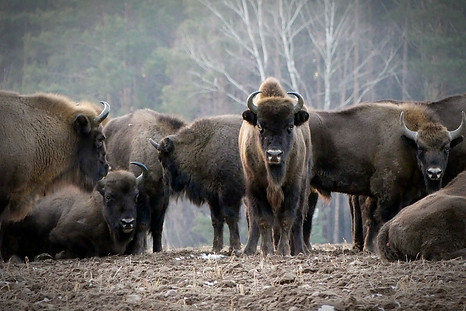
By and-kulak - Pixabay
European Bison
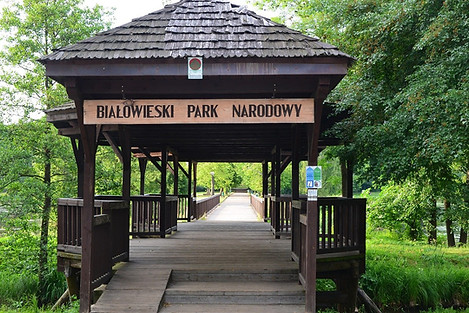
Bialowieza National Park
By mkoziol - Pixabay
Gdańsk
Gdańsk is a city in the north of Poland where the Vistula River meets the Baltic Sea. It is the largest and most important sea port in Poland, flourished during Medieval times. One of Poland’s most beautiful cities, with atmospheric Old Town district and the seaside charm, it's the Polish gateway to the sea.
The Artus Court and Fountain of Neptune
The Artus Court, used to be the meeting place of merchants and a centre of social life. Today it is a point of interest of numerous visitors and a branch of the Gdańsk History Museum.
Tatra Mountain
Tatra is a mountain range that forms a natural border between Slovakia and Poland They are the highest mountain range in the Carpathian Mountains.
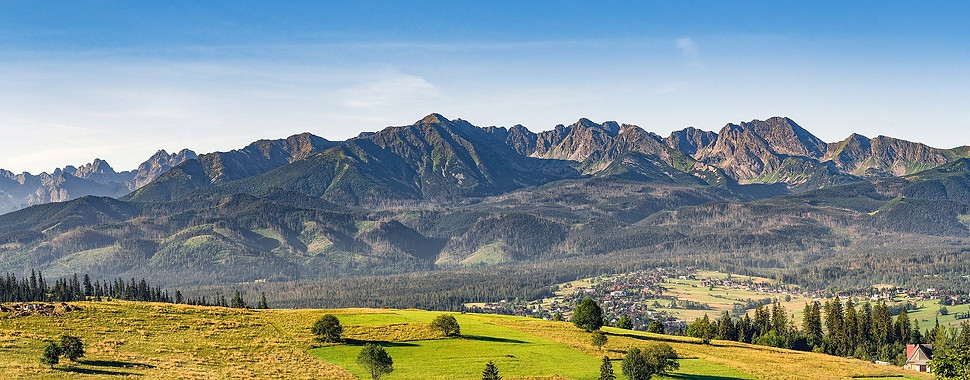
By Arek Socha - Pixabay
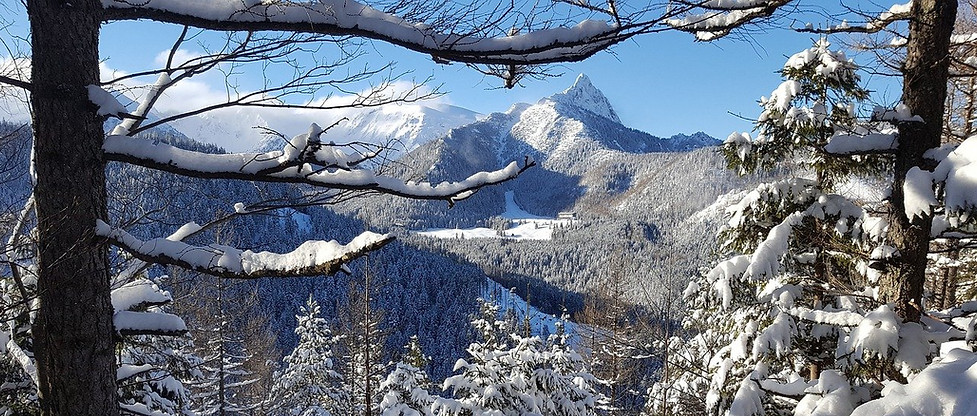
By Bartek12 - Pixabay
Wieliczka Salt Mine
The Wieliczka Salt Mine, located in the town of Wieliczka, lies within the Kraków metropolitan area, was inscribed in the very first UNESCO World Heritage List in 1978, along with the nearby Historical Centre of Kraków.
Excavated from the 13th century, the mine produced table salt continuously until the late 20th century. It is one of the earliest and most important European industrial operations and brought vast wealth to the Polish crown for the next 500 years.
The Wieliczka Salt Mine is now an official Polish Historic Monument, displaying hundreds of kilometres of galleries with shafts and labyrinthine passageways, underground chapels, an underground lake and numerous statues carved by miners out of the rock salt! Enjoy a fascinating journey into the past!

By Falk2 - wikimedia.org , CC BY-SA 4.0
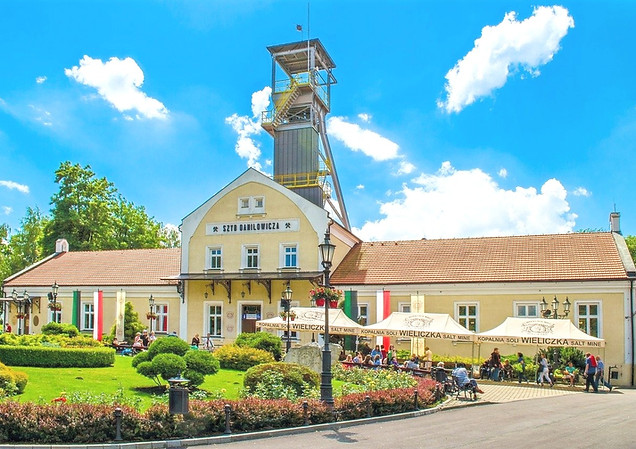
By Roman Polyanyk - Pixabay
Chapel of Saint Kinga
The splendid Chapel of Saint Kinga, an enormous hall lit by salt crystal chandeliers that took three men 67 years to carve and decorate. It contains altars, a copy of Leonardo da Vinci's "Last Supper "and a statue of John Paul II, all carved in salt.
Zakopane
Zakopane is a charming town located at the foothills of the majestic Tatra mountains and and Gubałówka Hill. Known as the winter capital of Poland, Zakopane is a winter wonderland that is also filled with things to do year-round.
It become immensely popular during winter, as the thick snow creates perfect skiing and winter activities conditions. During the summer, many visitors enjoy breathtaking mountain climbing, hiking and horse riding in the Tatras National Park.
If you don’t feel like skiing or hiking, you can simply spend your time relaxing in the thermal bath, admiring the soaring snowcapped mountains, landscape of enormous beauty around you.
Take a stroll along the Krupowki street, the most famous street in Zakopane, lined with many shops, pubs and tourist attractions.
Gubalowka Hill
The funicular ride from the center of Zakopane to the top of the Gubalowka Hill is one of the must-do during your stay in Zakopane. Gubalowka Hill offering sweeping views over the Tatra Mountains and Zakopane. There are also many attractions for the tourists - available both in summer and winter. It's worth to try a sleigh ride or a snowboarding course.
In Gubałówka, you can experience completely clean air, surrounded by beautiful green hills and mountains.
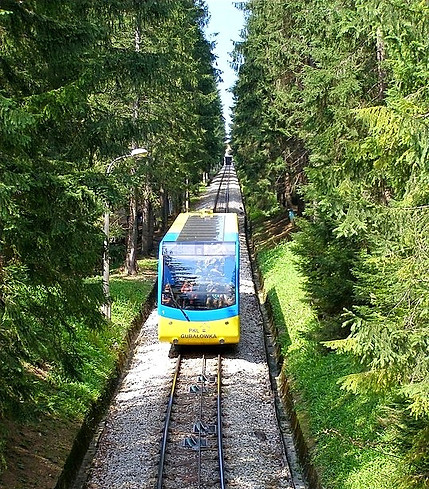
Funicular from Zakopane - Gubałówka
By Andrzej Otrębski - wikimedia.org, CC BY-SA 4.0
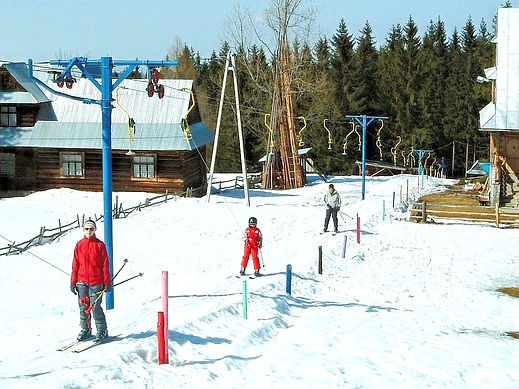_edited.jpg)
By Jonathanawhite -wikimedia.org, Public Domain
Zalipie Village
Il villaggio dipinto di Zalipie. Questo villaggio polacco è molto noto per la pittura di motivi floreali molto elaborati sulle pareti di quasi tutte le case. Uno dei villaggi più belli che potrai visitare!
Piatti nazionali della Polonia
Troverai ogni sorta di cibo in ogni città, ma in Polonia dovrai assolutamente provare dei piatti tipici, come il Bigos, cioè uno stufato di carne tritata di vario genere in umido con crauti e cavolo fresco tritato, oppure il Pierogis, una pasta arrotolata con vari ripieni.
Vodka polacca
I polacchi producono e bevono vodka sin dal primo Medioevo, distillando le loro abilità in alcune delle migliori miscele di vodka disponibili al mondo, molte delle quali risalgono a secoli fa.

By Alexnewworld - Pixabay

Traditional Oscypek cheese
By Piotrus - wikimedia.org, CC BY-SA 3.0
Polish Vodka
Poles have been producing and drinking vodka since the early Middle Ages, distilling their skill into some of the best vodka blends available in the world, many of which date back centuries.
Visita la Polonia quando sei pronto!
In Polonia, puoi provare la gioia di quattro stagioni distinte. Guarda il mondo diventare verde in primavera; goditi la piacevole estate in spiaggia o nella zona dei laghi; le sfumature romantiche delle foglie autunnali gialle che cadono; gustare un bicchiere di vodka o vin brulè dopo una giornata sugli sci in inverno. Un'atmosfera davvero magica a Natale, mentre la neve cade attorno al maestoso abete rosso e alle guglie ornate della cattedrale.
La Polonia è assolutamente un'ottima destinazione per il tuo prossimo viaggio in Europa.
Oltre alla Polonia, potresti arricchire il tuo viaggio visitando dei paesi nelle vicinanze, come la Germania, Repubblica Ceca e Slovacchia.
Se desideri includere un tour della Polonia come parte del tuo prossimo viaggio in Europa,
contattaci ora!
Mandaci semplicemente una e-mail con la richiesta di un tour e aspetta una nostra risposta per il preventivo, basato sulle tue esigenze e aspettative!






























































